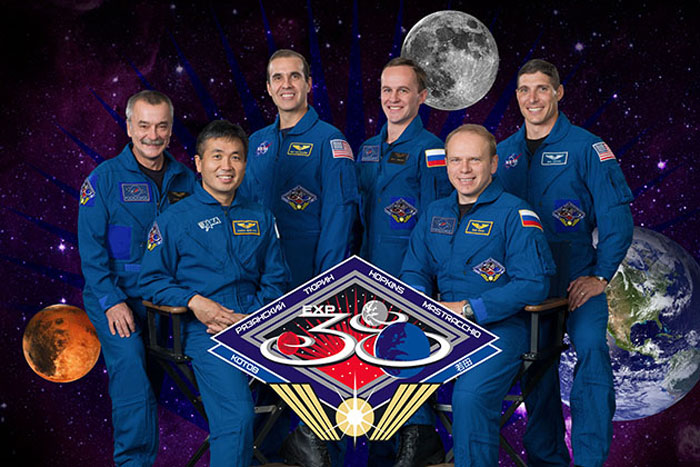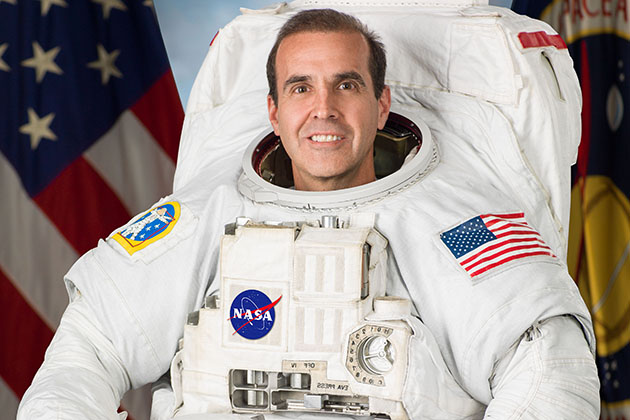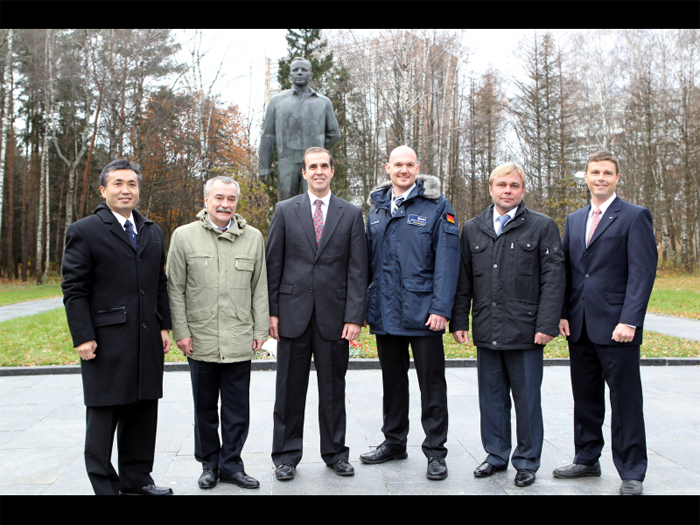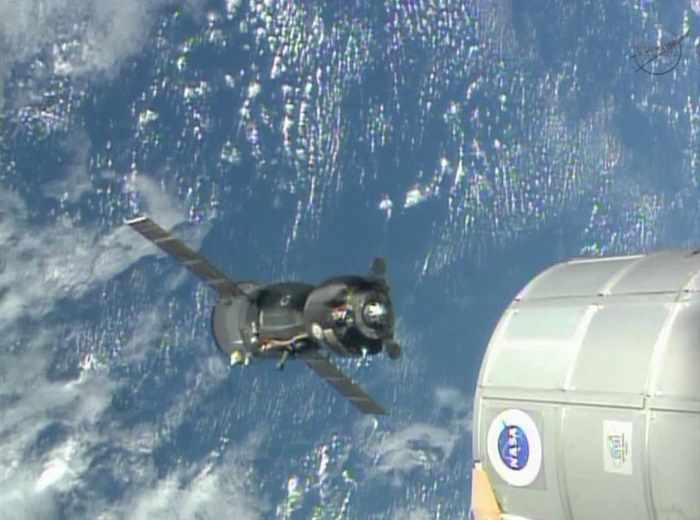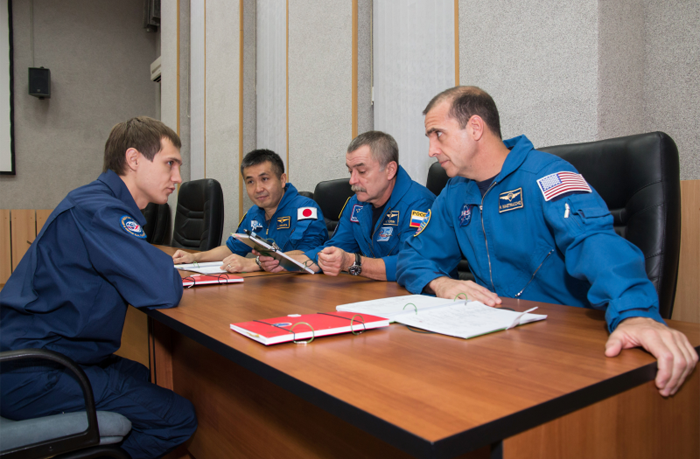Mastracchio will serve as a flight engineer for space station Expedition 38, which launches from the Baikonur Cosmodrome in Kazakhstan on Nov. 6. Unlike past trips, in which Mastracchio flew into orbit aboard one of the U.S. space shuttles and stayed in space for a just a few weeks, Expedition 38 is a prolonged space flight during which Mastracchio and the other astronauts will remain aboard the International Space Station from November to May 2014.
It’s a familiar homecoming for one of UConn’s most popular alums. Mastracchio helped prepare the International Space Station for its first human inhabitants when he first ventured into space in September 2000. Each time he returned (2007, 2010), he said the station seemed to get both bigger and more crowded. Once a small, cramped orbital docking station, the International Space Station is now a full-fledged flying laboratory the length and width of an American football field, including the end zones. It has the same living area as a five-bedroom house, two bathrooms, a gymnasium, and a 360-degree bay window. It weighs almost one million pounds or the equivalent of 320 automobiles.
“Every time I go to the International Space Station, it seems to get bigger and bigger and has more and more people,” Mastracchio said during a press conference this week at the Johnson Space Center in Houston. “This time, I look forward to living there and actually using the space station to do some of the work that was intended to be done there.”
As a mission flight engineer, Mastracchio’s primary role will be helping to guide the Soyuz spacecraft into space and back home at the end of the mission. While onboard the station, he will assist with various research projects, including one involving the burning and suppression of solids in microgravity to see how different materials combust in space and how such combustion can be prevented. Fire, obviously, is something astronauts hope to avoid in space. Expedition 38 also will be launching four satellites and conducting research into how zero gravity impacts the growth of protein crystals.
A specialist in operating the station’s 55-foot robotic arm, Mastracchio will be called upon to “capture” any visiting spacecraft. Arriving spacecraft no longer directly dock at the station but pull up alongside it, where they are “grabbed” by the station’s robotic arm and gently pulled into a holding place – a feat that takes a lot of skill when you’re flying at 17,500 mph about 240 miles above Earth.
A proud UConn alum and graduate of the UConn School of Engineering, Mastracchio credits his UConn experience with helping prepare him for his future endeavors in space.
“UConn had a lot to do with me getting where I am today,” Mastracchio said in a recent phone interview from Houston. “Very simply, the professors and classes I took at UConn taught me how to be an engineer. They worked me pretty hard there, I have to admit it; but I think I developed a lot of good skills at the University of Connecticut. I learned how to solve problems and overcome difficult tasks. It was not just the education but the training I received at the University of Connecticut in trying to become an engineer that helped me quite a bit early on in my career, and it all kind of built upon that.”
A native of Waterbury, Conn., Mastracchio graduated from UConn in 1982 with a bachelor of science degree in electrical engineering and computer science. He went on to earn a master’s degree in electrical engineering from Rensselaer Polytechnic Institute in 1987, and a master’s degree in physical science from the University of Houston-Clear Lake in 1991. Mastracchio worked for Hamilton Standard in Connecticut during his graduate years, before joining the Rockwell Shuttle Operations Co. at the Johnson Space Center in Houston in 1987. He first applied to be an astronaut in 1987, and kept re-applying each year for the next nine years. He was finally selected by NASA in 1996.
When asked what advice he would give others who wish to follow in his footsteps, Mastracchio said: “Find something you really enjoy and become really good at it. Obtain a master’s degree or a doctorate in that field, and then throw your name in a hat. It took me nine years to become an astronaut. But even if you don’t become an astronaut, you will still have a wonderful career to fall back on.”
.
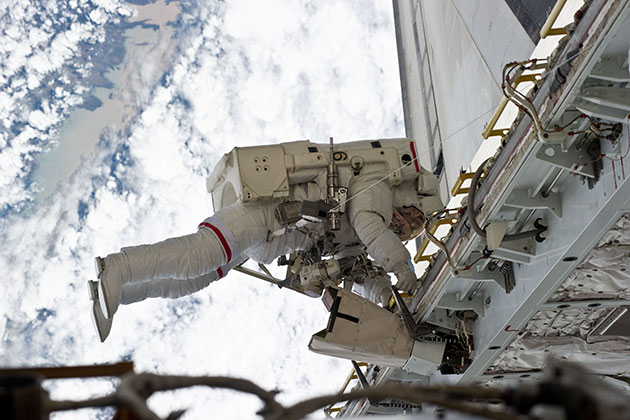
UConn alum Richard Mastracchio is a veteran of six spacewalks. (Photo/NASA)
.
A veteran of six spacewalks totaling more than 38 hours in space, Mastracchio says he’ll be bringing a UCONN baseball cap with him on his latest mission. On a prior mission, he brought a UConn banner on to the space shuttle and selected the UConn Husky fight song “Hail, Hail, UConn” as one of his pieces of “wake-up” music to be played by mission control. The space-bound banner was later returned to Storrs and remains on display in the Lodewick Visitors Center.
This time, there will be another unique item tagging along with the Expedition 38 crew – the Olympic torch. As part of the symbolic torch relay prior to the 2014 Winter Olympic Games in the Russian city of Sochi, Russian cosmonauts will carry the torch and simulated flame during a spacewalk outside the International Space Station during the mission. The torch will then be returned to Earth in time to continue the relay to Sochi before the games’ opening ceremonies on Feb. 7.
Mastracchio is very active on social media. You can follow his pre-flight training preparations – including a fascinating array of behind-the-scenes photos and video clips – through his Twitter account @AstroRM.
NASA is also offering followers a chance to become “virtual crewmembers” of Expedition 38 by participating in a monthly trivia contest through Mastracchio’s Twitter account. Each month, Mastracchio will ask a trivia question about his training for followers to answer. Questions will range from science research and on-orbit medical operations to spacewalk procedures and robotics. The first person to reply with the correct answer wins. Participants should use the hashtag #ISSFE7 after their reply. Winners will have their photos uplinked to the International Space Station, where Mastracchio will take a photograph of the picture with the Earth in the background. A complete list of the contest rules can be found here.
Read more about the mission at www.nasa.gov/station, and watch the mission at www.nasa.gov/ntv.
Mastracchio is the second UConn alumnus to travel into space. Franklin Chang-Diaz, a 1973 UConn graduate, is a veteran astronaut with six successful flights to his credit. Chang-Diaz retired from NASA in 2005.
Quelle: UConn - University of Connecticut
.
Update: 28.10.2013
.
Besatzungen der nächsten ISS-Expedition für Baikonur
.
The prime crew of International Space Station Expedition 38/39 and the backup crew flew out from Chkalovsky airport located near Moscow for Baikonur on Saturday, the press secretary of the Cosmonaut Training Centre, Irina Rogova, told Itar-Tass.
Cosmonauts traditionally are carried by two planes to the space launch centre. The first plane with Russian Mikhail Tyurin, NASA astronaut Richard Mastracchio and Japanese astronaut Koichi Wakata aboard took off at 10:00 Moscow time, and the second plane with the backup crewmembers -- Maxim Surayev, Gregory Wiseman and Alexander Gerst -- took off at 10:20.
Before the flight, the cosmonauts and astronauts said good-bye to their families and were photographed at the Yuri Gagarin monument in cosmonauts' Star City. They will continue training before the orbital expedition. The launch of the Soyuz TMA-11M spacecraft is planned for November 7.
The Sochi 2014 torch, a symbol of the Winter Olympic Games, will be carried to the ISS aboard the Soyuz. Olympic symbols are on the emblem of the crew and on the spacecraft.
The Soyuz is planned to arrive at the space station in less than six hours.
Quelle: ITAR-TASS
.
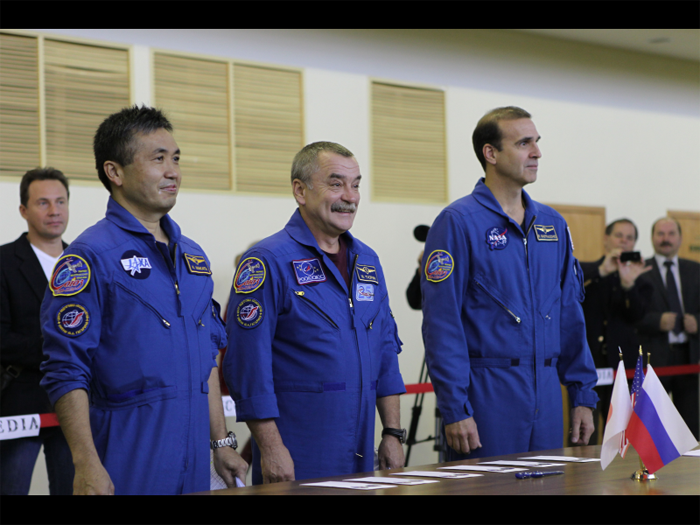
Koichi Wakata, Mikhail Tyurin and Rick Mastracchio
JSC2013-E-090222 (15 Oct. 2013) --- At the Gagarin Cosmonaut Training Center in Star City, Russia, Expedition 38 Flight Engineer Koichi Wakata of the Japan Aerospace Exploration Agency (left), Soyuz Commander Mikhail Tyurin (center) and NASA Flight Engineer Rick Mastracchio (right) report for the start of their flight qualification exam simulations Oct. 15, 2013. The trio is scheduled to launch on Nov. 7, local time, from the Baikonur Cosmodrome in Kazakhstan on the Soyuz TMA-11M spacecraft for a six-month mission on the International Space Station. Photo credit: NASA
.
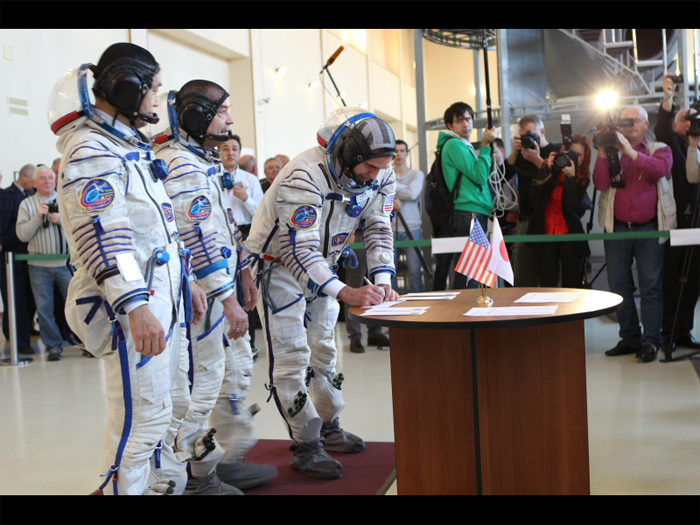
Rick Mastracchio, Koichi Wakata and Mikhail Tyurin
JSC2013-E-090228 (17 Oct. 2013) --- At the Gagarin Cosmonaut Training Center in Star City, Russia, Expedition 38/39 Flight Engineer Rick Mastracchio of NASA (right) signs in for final qualification exam simulations Oct. 17, 2013 as his crewmates, Flight Engineer Koichi Wakata of the Japan Aerospace Exploration Agency (left) and Soyuz Commander Mikhail Tyurin (center) look on. The trio is scheduled to launch on Nov. 7, local time, from the Baikonur Cosmodrome in Kazakhstan on the Soyuz TMA-11M spacecraft for a six-month mission on the International Space Station. Photo credit: NASA
.
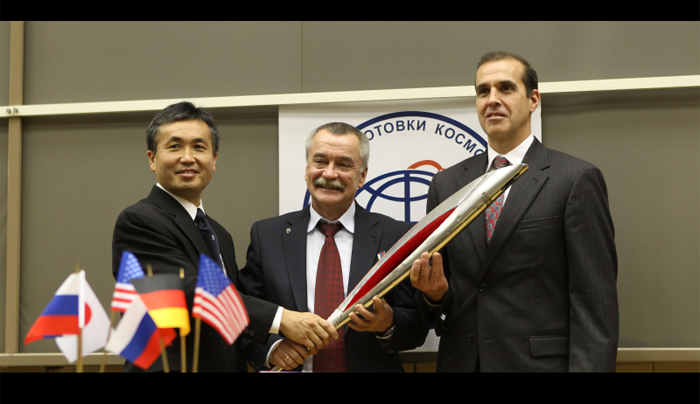
Expedition 38 Crew With Model of Olympic Torch
JSC2013-E-090724 (22 Oct. 2013) ---At the Gagarin Cosmonaut Training Center in Star City, Russia, Expedition 38 Flight Engineer Koichi Wakata of the Japan Aerospace Exploration Agency (left), Soyuz Commander Mikhail Tyurin (center) and NASA Flight Engineer Rick Mastracchio pose for pictures with a model of the Olympic torch following a crew news conference Oct. 22, 2013. The trio is scheduled to launch Nov. 7, Kazakh time, from the Baikonur Cosmodrome in Kazakhstan on the Soyuz TMA-11M spacecraft for the start of a six-month mission on the International Space Station. Launching with the the crew will be one of the Olympic torches used in the Olympic relay that will culminate with the torch’s arrival at the opening ceremonies of the 2014 Winter Olympics in Sochi, Russia next February. Photo credit: NASA
.
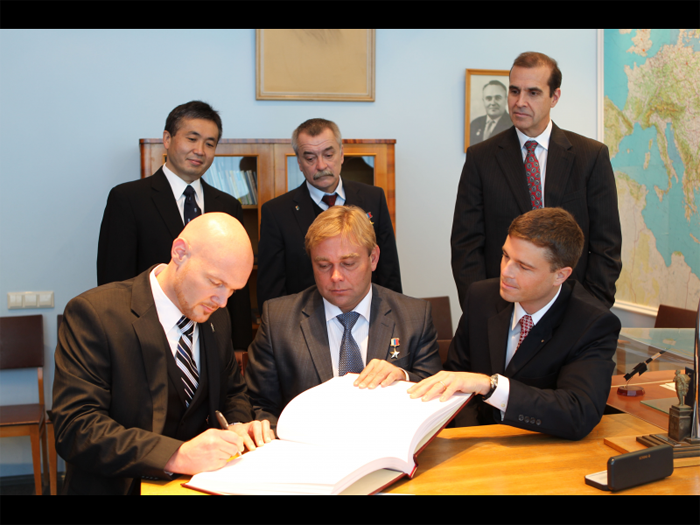
Astronaut Alexander Gerst Signs Commemorative Book
JSC2013-E-090719 (22 Oct. 2013) --- At the Gagarin Museum located at the Gagarin Cosmonaut Training Center in Star City, Russia, Expedition 38/39 backup Flight Engineer Alexander Gerst of the European Space Agency (front row, left) signs a commemorative book Oct. 22, 2013 as his crewmates, Soyuz Commander Max Suraev (front row, center) and NASA Flight Engineer Reid Wiseman (front row, right) look on. Joining them in the back row from left to right are prime crew members Koichi Wakata of the Japan Aerospace Exploration Agency, Soyuz Commander Mikhail Tyurin and NASA’s Rick Mastracchio, who will launch Nov. 7, Kazakh time from the Baikonur Cosmodrome in Kazakhstan on the Soyuz TMA-11M spacecraft for the start of a six-month mission on the International Space Station. Photo credit: NASA
.
Expedition 38 Prime and Backup Crew Members
JSC2013-E-090729 (22 Oct. 2013) --- At the Gagarin Cosmonaut Training Center in Star City, Russia, the Expedition 38/39 prime and backup crew members pose for pictures in front of the statue of Yuri Gagarin, the first human to fly in space, Oct. 22, 2013 following a news conference and traditional ceremonies. Front left to right are prime crew members -- Flight Engineer Koichi Wakata of the Japan Aerospace Exploration Agency, Soyuz Commander Mikhail Tyurin and Flight Engineer Rick Mastracchio of NASA -- and backup crew members Alexander Gerst of the European Space Agency, Max Suraev of Russia's Federal Space Agency and NASA’s Reid Wiseman. Wakata, Tyurin and Mastracchio are scheduled to launch Nov. 7, Kazakh time, from the Baikonur Cosmodrome in Kazakhstan on the Soyuz TMA-11M spacecraft for the start of a six-month mission on the International Space Station. Photo credit: NASA
.
Quelle: NASA
.
Update: 30.10.2013
.
Three Space Station Crews Get Ready for Relocation, Launch, Landing
.
International Space Station crews commuting to and from their orbiting laboratory will be busy this November, and NASA Television will provide live coverage of their launches, landings and relocations.
Traffic starts to pick up Friday, Nov. 1. Expedition 37 Commander Fyodor Yurchikhin of the Russian Federal Space Agency (Roscosmos) and Flight Engineers Karen Nyberg of NASA and Luca Parmitano of the European Space Agency will climb into their Soyuz spacecraft, back out of one Russian Earth-facing docking spot and fly a short distance to another one at the end of the station. NASA TV coverage starts at 4 a.m. EDT. The 24-minute maneuver begins with undocking at 4:34 a.m.
The Soyuz move opens up the Rassvet docking port for another Soyuz transporting Expedition 38/39 Flight Engineer Rick Mastracchio of NASA, Soyuz Commander Mikhail Tyurin of Roscosmos and Flight Engineer Koichi Wakata of the Japan Aerospace Exploration Agency to the station. Aboard their spacecraft is the Olympic torch, which is taking an out-of-this-world route -- as part of the torch relay -- to Fisht Stadium in Sochi, Russia. There, the torch will be used to light the Olympic flame at the stadium, marking the start of the 2014 winter games.
The trio is scheduled to launch at 11:14 p.m. EST Wednesday, Nov. 6 (10:14 a.m. Kazakh time on Nov. 7) from the Baikonur Cosmodrome in Kazakhstan. NASA TV launch coverage begins at 10:15 p.m. Docking to Rassvet is scheduled at 5:31 a.m. on Nov. 7, with NASA TV coverage beginning at 4:45 a.m. Hatches are scheduled to open at 7:40 a.m., with NASA TV coverage starting at 7:15 a.m.
Mastracchio, Tyurin and Wakata will join Yurchikhin, Nyberg and Parmitano, plus Oleg Kotov and Sergey Ryazanskiy of Roscosmos and Michael Hopkins of NASA. Their arrival will be the first time since May 2009 that nine people have served together aboard the space station without the presence of a space shuttle.
On Sunday, Nov. 10, after Yurchikhin has transferred command of the station to Kotov, the Soyuz carrying Yurchikhin, Nyberg and Parmitano will undock for a parachute-assisted landing on the steppe of Kazakhstan at 9:50 p.m. (8:50 a.m. Kazakh time on Nov. 11), wrapping up a 166-day mission. Hatch closure coverage begins at 2:30 p.m. Nov. 10 with a replay of the change of command ceremony. Undocking coverage begins at 6 p.m., and deorbit and landing coverage begins at 8:30 p.m.
Special video feeds of pre-launch activities by the crew will resume on Friday, Nov. 1, and continue through Wednesday, Nov. 6.
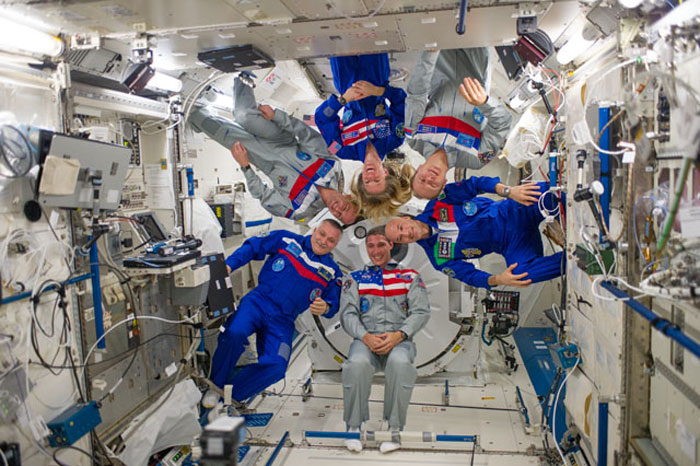
Quelle: NASA
.
Update: 1.11.2013
.
Soyuz Move Sets Stage for Arrival of New Crew
.
The Soyuz TMA-09M under the command of Expedition 37 Commander Fyodor Yurchikhin backs away from the International Space Station's Rassvet module for a flyaround to the aft port of the Zvezda service module. .
.
Three International Space Station crew members took their Soyuz for a spin around the block Friday as they prepare for the extremely busy final week of Expedition 37.
Commander Fyodor Yurchikhin and Flight Engineers Karen Nyberg and Luca Parmitano undocked their Soyuz TMA-09M spacecraft from the Rassvet module on the Earth-facing side of the station at 4:33 a.m. EDT Friday. After backing the vehicle a safe distance away, Soyuz Commander Yurchikhin rotated the Soyuz and began the flyaround to the rear of the station. Carefully aligning the spacecraft with the docking port on the aft end of the Zvezda service module, which was vacated by the European Space Agency’s fourth Automated Transfer Vehicle (ATV) on Monday, Yurchikhin guided the spacecraft in for its docking at 4:54 a.m.
Coincidentally, Yurchikhin was at the helm for the last Soyuz relocation at the station in June 2010 when he piloted the Expedition 24 crew’s Soyuz TMA-19 vehicle from Zvezda to the then newly installed Rassvet module.
Friday’s Soyuz move sets the stage for the launch and arrival of a trio of new station crew members -- NASA astronaut Rick Mastracchio, Japan Aerospace Exploration Agency astronaut Koichi Wakata and Soyuz Commander Mikhail Tyurin of the Russian Federal Space Agency – who will dock their Soyuz TMA-11M spacecraft to Rassvet on Nov. 7 about six hours after their launch from the Baikonur Cosmodrome in Kazakhstan.
The arrival of Mastracchio, Wakata and Tyurin will mark the first time since October 2009 that nine people have served together aboard the station without the presence of a space shuttle.
Also arriving to the station aboard the Soyuz TMA-11M will be the Olympic torch, which is making the longest leg of its relay leading up to the 2014 Winter Olympics in Sochi, Russian. Flight Engineers Oleg Kotov and Sergey Ryazanskiy will take the Olympic torch outside the station during a symbolic spacewalk on Nov. 9.
The torch will return to Earth along with Yurchikhin, Nyberg and Parmitano on Nov. 10 when they board their Soyuz for the journey home after more than five months in space.
The final departure of Yurchikhin, Nyberg and Parmitano will free the Zvezda port for the docking of a new Progress resupply vehicle in late November. Program managers prefer to have a Progress or ATV cargo ship docked at Zvezda so it can help reboost the station and adjust its attitude.
Quelle: NASA
.
Update: 4.11.2013
.
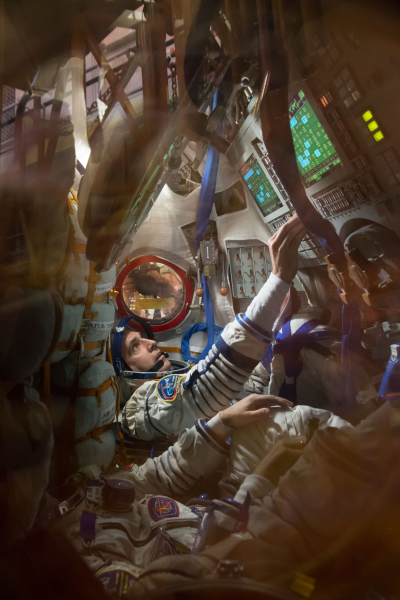
Rick Mastracchio participates in a fit check dress rehearsal
JSC2013-E-091199 (28 Oct. 2013) --- In the Integration Facility at the Baikonur Cosmodrome in Kazakhstan, Expedition 38/39 Flight Engineer Rick Mastracchio (top) participates in a fit check dress rehearsal Oct. 28 in the Soyuz TMA-11M spacecraft with his crewmates, Soyuz Commander Mikhail Tyurin and Flight Engineer Koichi Wakata of the Japan Aerospace Exploration Agency. The three are scheduled to launch Nov. 7, Kazakh time, in the Soyuz spacecraft from Baikonur to begin a six-month mission on the International Space Station. Photo credit: NASA/Victor Zelentsov
.

Expedition 38 pose in front of the Soyuz upper stage booster rocket
JSC2-13-E-091201 (28 Oct. 2013) --- In the Integration Facility at the Baikonur Cosmodrome in Kazakhstan, Expedition 38 Flight Engineer Koichi Wakata of the Japan Aerospace Exploration Agency (left), Soyuz Commander Mikhail Tyurin (center) and Flight Engineer Rick Mastracchio of NASA pose for pictures Oct. 28 in front of the upper stage of the Soyuz booster rocket following a fit check dress rehearsal inside the Soyuz. The rocket is adorned with the logo of the Sochi Olympic Organizing Committee and other related artwork to commemorate the launch of the Olympic torch with the crew for a four-day visit to the station. The torch will return to Earth with another trio of station residents on Nov. 11 and will be part of the torch relay that ends with the lighting of the flame at the Fisht Stadium in Sochi, Russia Feb. 7 to mark the opening of the 2014 Winter Olympics. Photo credit: NASA/Victor Zelentsov
.
Expedition 38 Trio Trains for Launch
JSC2013-E-091595 (1 Nov. 2013) --- At their Cosmonaut Hotel crew quarters in Baikonur, Kazakhstan, Expedition 38 Flight Engineer Koichi Wakata of the Japan Aerospace Exploration Agency (left), Soyuz Commander Mikhail Tyurin (center) and Flight Engineer Rick Mastracchio of NASA brush up on their flight plan with a training instructor Nov. 1. They are preparing for launch Nov. 7, Kazakh time, from the Baikonur Cosmodrome aboard the Soyuz TMA-11M spacecraft. Their scheduled launch will begin a six-month mission on the International Space Station. Photo credit: NASA/Victor Zelentsov
.
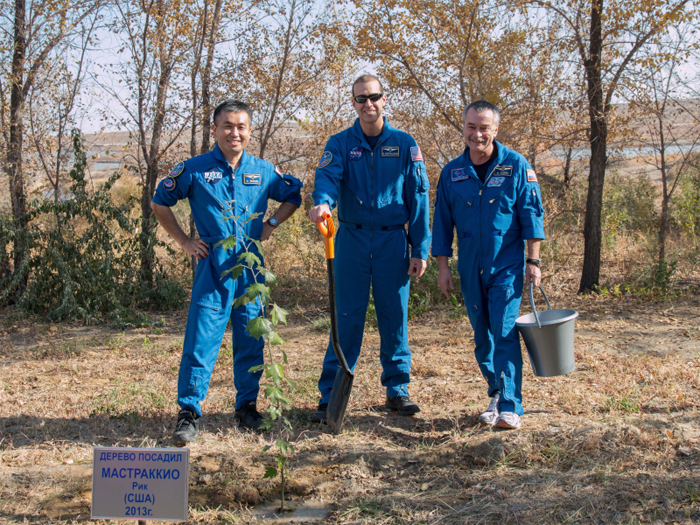
Expedition 38 Tree Planting Ceremony
JSC2013-E-091600 (1 Nov. 2013) --- Behind their Cosmonaut Hotel crew quarters in Baikonur, Kazakhstan, Expedition 38 Flight Engineer Koichi Wakata of the Japan Aerospace Exploration Agency (left), Flight Engineer Rick Mastracchio of NASA (center) and Soyuz Commander Mikhail Tyurin pose for pictures Nov. 1. Mastracchio had just planted a tree in his name in a ceremonial pre-flight tradition. The trio is preparing for its scheduled launch Nov. 7, Kazakh time from the Baikonur Cosmodrome aboard the Soyuz TMA-11M spacecraft to begin a six-month mission on the International Space Station. Photo credit: NASA/Victor Zelentsov
.

Expedition 38 Trio in Kazakhstan
JSC2013-E-091604 (1 Nov. 2013) --- Behind the Cosmonaut Hotel crew quarters in Baikonur, Kazakhstan, Expedition 38 Flight Engineer Koichi Wakata of the Japan Aerospace Exploration Agency (left), Soyuz Commander Mikhail Tyurin (center) and Flight Engineer Rick Mastracchio pose for pictures Nov. 1 as they prepare for their scheduled launch Nov. 7, Kazakh time from the Baikonur Cosmodrome aboard the Soyuz TMA-11M spacecraft to begin a six-month mission on the International Space Station. Photo credit: NASA/Victor Zelentsov
.
Quelle: NASA
.
Update: 5.11.2013
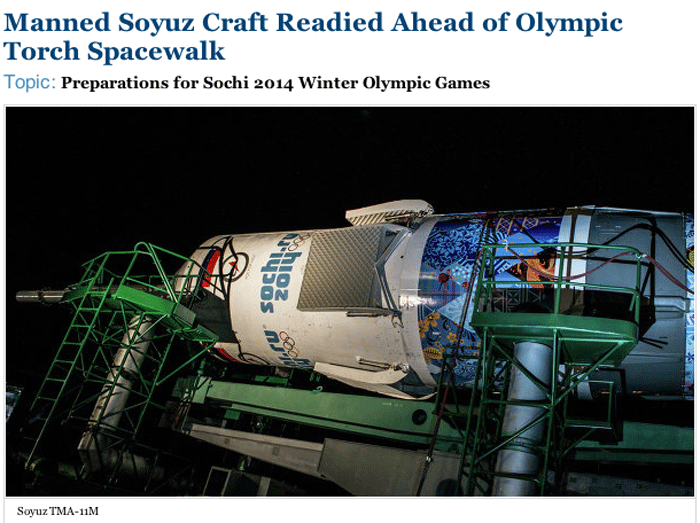
A Soyuz TMA-11M spacecraft was hoisted into place at a launch pad in Kazakhstan's Baikonur cosmodrome Tuesday morning ahead of a mission to take three astronauts to the manned International Space Station.
The crew, consisting of Russian cosmonaut Mikhail Tyurin, NASA’s Richard Mastracchio and Koichi Wakata of Japan, is set to blast off Thursday from the Russian-leased facility.
The Soyuz will be carrying an unlit Olympic torch, making for the most eye-catching, albeit unofficial, part of a grand relay taking place ahead of the Winter Games in and around the southern Russian resort town of Sochi in February.
The torch will be taken on a brief spacewalk Saturday by Russian cosmonauts Oleg Kotov and Sergey Ryazanskiy, who are one of the six people currently aboard the space station.
The arrival of the Soyuz TMA-11M will take the number of people on the ISS to nine for the first time since October 2009 without the US shuttle, which was definitively retired in the middle of 2011.
The main purpose of the spacewalk will be to prepare the station for the arrival of a Russian Multi-Purpose Laboratory Module.
The outbound trio will remain on the International Space Station until May. Wakata,of the Japanese Aerospace Exploration Agency, is set to take the helm of the station for the final two months. That will mark the first time in history that the ISS has had a Japanese commander.
Luca Parmitano, an Italian astronaut with European Space Agency, Russia’s Fyodor Yurchikhin and NASA’s Karen Nyberg are set to return to earth on Sunday.
.
Quelle: RIA NOVOSTI
.
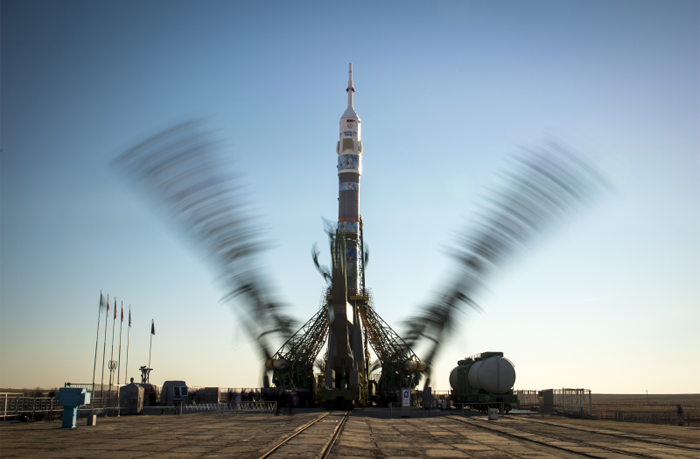
Soyuz Rocket Ready to Launch New Station Crew
The Soyuz TMA-11M rocket, adorned with the logo of the Sochi Olympic Organizing Committee and other related artwork, is seen in this long exposure photograph, as the service structure arms are raised into position at the launch pad on Tuesday, Nov. 5, 2013, Baikonur Cosmodrome in Kazakhstan. Launch of the Soyuz rocket is scheduled for November 7 and will send Expedition 38 Soyuz Commander Mikhail Tyurin of Roscosmos, Flight Engineer Rick Mastracchio of NASA and Flight Engineer Koichi Wakata of the Japan Aerospace Exploration Agency on a six-month mission aboard the International Space Station.
The crew will deliver the Olympic torch, and spacewalkers Kotov and Ryazanskiy will carry it outside the station on Saturday. The torch, returning home with Expedition 37, will light the flame at the opening of the 2014 Winter Olympic Games in Sochi, Russia.
Quelle: NASA
